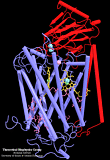Cytochrome c Oxidase

Subunits I and II of cytochrome c oxidase, including Heme groups and metal
centers. The picture was produced using VMD and Radiance. Click on the
image for a bigger version (150K).
Cytochrome c oxidase, the terminal enzyme in the respiratory chain, is located in the inner membrane of mitochondria and bacteria. It catalyses the reduction of dioxygen to water and pumps an additional proton across the membrane for each proton consumed in the reaction. The resulting electro-chemical gradient is used elsewhere, for instance in the synthesis of ATP.
Recently, crystal structures at a resolution of 2.8 Å have been reported for cytochrome c oxidase from Paracoccus denitrificans [1] and from bovine heart [2,3]. The protein contains two heme and two copper sites. The reaction center for the reduction of oxygen is a binuclear center formed by the iron of a heme a3 and copper CuB. In the course of the reaction cycle four protons have to be transferred from the matrix side of the membrane to the oxygen, and an additional four protons are pumped across the membrane using the free energy released in the reaction.
Knowledge of the static structure is, however, not sufficient to understand the molecular mechanism that couples oxygen reduction to proton translocation, since proton pumping must involve structural changes. Furthermore, internal waters that might be involved in proton transfer cannot be resolved in the crystal structure. The project is a collaboration with the group of H. Michel at the Max-Planck Institute in Frankfurt, Germany, who solved the Paracoccus structure.
Using molecular dynamics and quantum chemical calculations on the binuclear center we will study:
- Along what path are consumed protons transferred to the binuclear center?
- What is the pathway for protons that are pumped across the membrane?
- How does molecular dioxygen reach the binuclear center?
- How is the pumping of protons coupled to the chemical reaction to achieve vectorial transport?
The diffusion of oxygen to the binuclear center can be studied in molecular dynamics simulations. To reduce the computational effort, we employ the enhanced sampling technique of Elber et al.[5], in which a swarm of ligand molecules is used to obtain several trajectories in one MD run. Our preliminary results are consistent with a pathway starting at the cleft of subunit III.
Finally, we will carry out quantum chemical calculations to predict changes in the binuclear center upon binding and reduction of oxygen and evaluate proposed mechanism for the linkage of redox chemistry and proton pumping.



